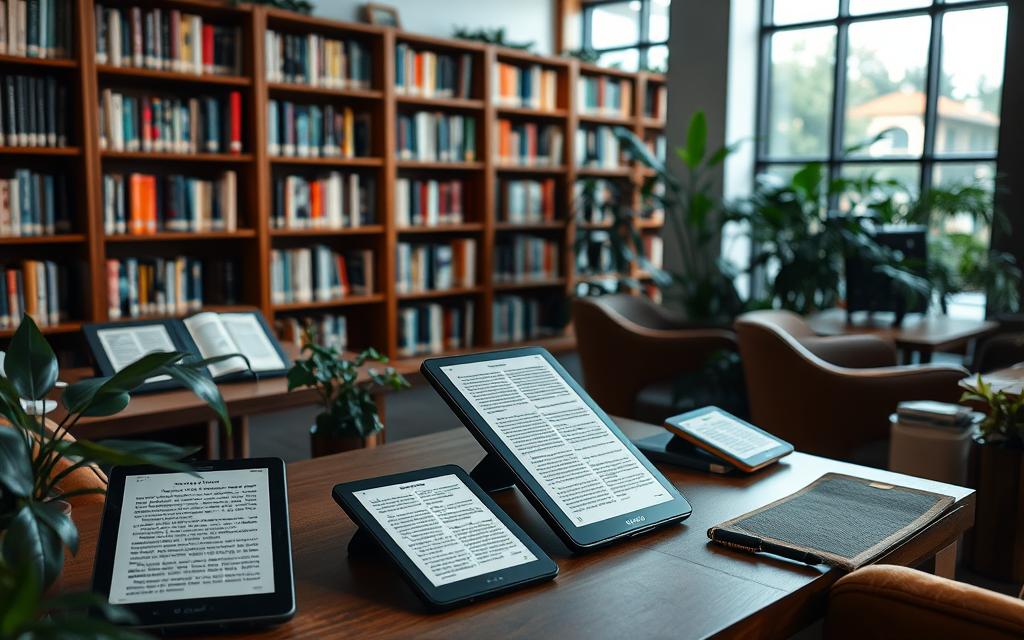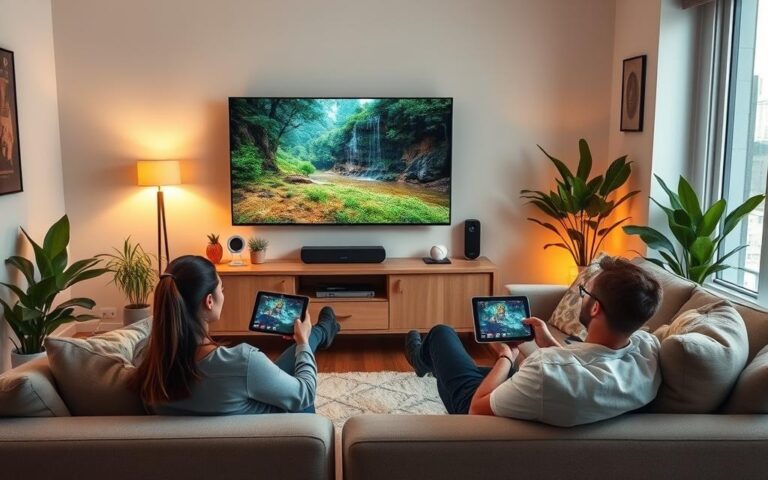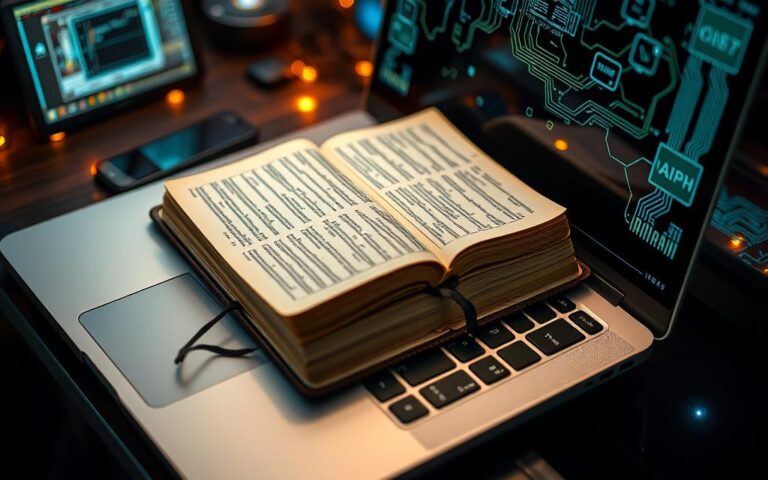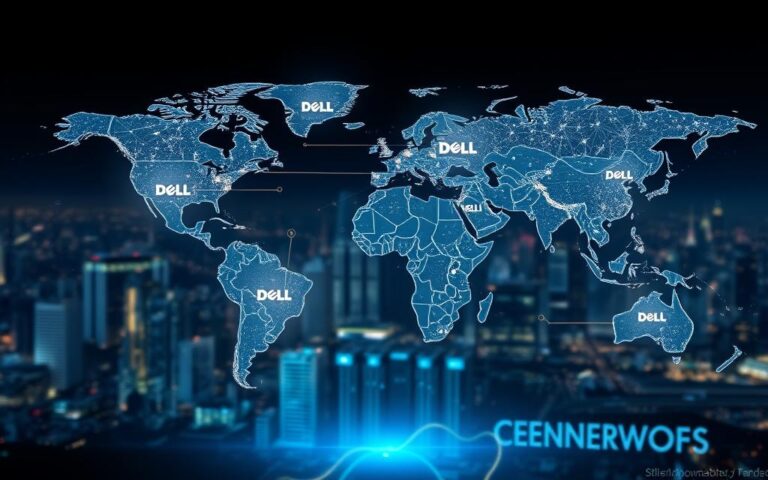Exploring E-Ink Technology and Its Uses
E-ink technology has changed how we read digital content. It’s especially good for book lovers and professionals. This tech mimics reading on paper, making it easy on the eyes.
It also cuts down on glare and saves energy. This is why e-readers and digital signs use it.
We’ll look into e-ink displays and their benefits. We’ll also cover its history and uses. From e-readers to retail and healthcare, e-ink makes digital reading better.
Introduction to E-Ink Technology
E-Ink technology was introduced in 1999 and has changed how we view digital content. It looks like real ink, making reading feel like paper. This tech is also energy-efficient, which is why it’s used in many places.
E-ink displays work with tiny capsules that change colour with little energy. This makes them perfect for devices that need to save power.
Today, e-ink holds over 90% of the e-paper market. Companies like Amazon use it in their Kindles. E-ink screens also use much less power than old screens, which is good for the planet.
E-ink is now in smart signs, traffic signs, and even wearables. It shows how versatile and efficient it is. As e-ink tech gets better, so will its uses.
What is E Ink Technology?
E Ink technology was first developed in 1996 by MIT Media Lab scientists. It makes reading feel like looking at ink on paper. The E-Ink Corporation holds the patent for this technology, leading to many display types, like E-Ink Vizplex and E-Ink Pearl.
Overview of Electronic Ink
E-ink is made of tiny capsules filled with black and white particles. These particles can move to show different patterns on screens. This technology uses less power, making devices last for weeks without needing to be charged.
How E-Ink Works
E-ink technology works by moving charged particles to show images and text. When electricity is applied, the particles move to the surface. This shows how e-ink is efficient, using power only when changing images. It also doesn’t emit light, reducing glare and making it great for reading outside.
Learning about e-ink can make you think about its uses in different areas. The technology has improved over time, with new versions being introduced. For more information, check out the Cookie Policy, which talks about how these technologies affect user experiences.
Advantages of E-Ink Technology
E-ink technology has many benefits, making it a top choice for different uses. It’s known for being energy-efficient, comfortable for the eyes, and uses less power. These features make e-ink better than traditional displays in many ways.
Energy Efficiency
E-ink displays are a big step up in display tech. They only use power when changing images, unlike regular screens. This means devices like e-readers can last for weeks on one charge.
This long battery life is great for places where power is scarce. It shows how e-ink is better for saving energy.
Eye Comfort and Readability
E-ink is great for readers because it’s easy on the eyes. It looks like printed paper, which reduces eye strain. This is unlike backlit screens.
Its high reflectivity also means it works well in different lights. This makes reading easier, even in bright sunlight. So, e-ink is perfect for those who love to read a lot.
Low Power Consumption
E-ink displays use less power, which is good for the planet. They need to be charged less often than LCD screens. This makes them more cost-effective over time.
They’re especially good for people in remote or outdoor areas. E-ink technology is a sustainable choice for today’s eco-aware users.
| Advantage | Description |
|---|---|
| Energy Efficiency | Consumes power only when the image changes, resulting in long battery life. |
| Eye Comfort | Reflects light to reduce eye strain and improves readability in various conditions. |
| Low Power Consumption | Requires less frequent charging, supporting eco-friendly and cost-effective use. |
History and Development of E-Ink Technology
The story of e-ink technology started in the mid-1990s at MIT’s Media Lab. In 1996, the first patent for microencapsulated electrophoretic displays was filed. This was a key moment in e-ink’s history, setting the stage for its growth.
A team led by JD Albert and Barrett Comiskey founded E Ink Corporation in 1997. They worked together to develop new ideas and innovations.
Over the years, e-ink technology has seen many important milestones. The first e-reader was launched in Japan in 2004. This was followed by the Amazon Kindle in 2007, which made e-ink popular worldwide.
The E Ink Vizplex was introduced in 2007, improving display quality. It made reading on screens more comfortable and clear.
In 2012, E Ink Corporation bought SiPix, expanding its market share. By 2009, E Ink Holdings Inc. bought E Ink Corporation for $450 million. This showed how valuable e-ink technology had become.
In 2015, E Ink announced flexible displays called E Ink Prism. This showed how e-ink could be used in many different ways.
Today, e-ink displays are in many devices, thanks to partnerships with Sony, Ledger, Motorola, and Amazon. These displays offer a reading experience like paper, using very little power. They also open up new possibilities for signs and ads.
The journey of e-ink technology is a story of dedication and creativity. It shows how pioneers have shaped this exciting field, paving the way for future breakthroughs.
Different Types of E-Ink Displays
E-Ink technology has changed how we see digital content. It offers many types of e-paper for different needs. These are mainly flexible and non-flexible, each with its own benefits.
Flexible vs. Non-Flexible Electronic Paper Displays
Flexible e-ink displays are very versatile. They’re great for wearables and smartphones because they can bend. This makes them light and easy to use.
On the other hand, non-flexible e-ink is like traditional screens. It’s mainly used in e-readers like the Kindle Paperwhite. These devices are perfect for reading and have features like adjustable warmth for better reading in the dark.
Colour E-Ink Technology
Colour e-ink displays have become more common, thanks to E Ink’s Kaleido technology. They use a grayscale background with colour filters. This makes the colours more vibrant but still easy on the eyes.
These displays are great for things like magazines or comics. They’re not as bright as LCD screens but are still engaging. Their low power use makes them useful for many things.
| Display Type | Characteristics | Applications |
|---|---|---|
| Flexible E-Ink Displays | Bendable, lightweight, versatile | Wearables, smartphones |
| Non-Flexible E-Ink Displays | Rigid, traditional screen feel | E-readers, digital note-taking devices |
| Colour E-Ink Displays (Kaleido) | Grayscale with colour filters | Magazines, comics, educational materials |
| Advanced Colour E-Paper (ACeP) | Supports more than 4,000 colours | High-end applications requiring detailed colour displays |
Knowing about these e-paper types shows how e-ink technology is adaptable. It keeps evolving, opening up new possibilities in many fields.
Applications of E-Ink Technology
E-Ink technology is used in many areas, changing how we get and use information. It’s great for different uses because of its special features. Here are some key places where e-ink technology shines.
E-Readers and Digital Books
E-readers have changed how we read. Devices like Amazon Kindle use e-ink technology for a reading experience like real books. This e-ink in literature has high resolution and is easy to read in any light. It’s perfect for book lovers.
E-readers are great because they’re portable and have lots of books. You can carry your whole library with you.
Electronic Shelf Labels in Retail
In retail, electronic shelf labels have changed how stores work. They let prices and product info change instantly, cutting down on paper waste. E-ink in retail makes things clear and easy to see, no matter the light.
Stores save money and work better with these labels. It’s a win-win for everyone.
Smart Signage Solutions
Smart signage with e-ink is becoming popular, especially in public places. This digital signage innovation is good at showing info clearly and uses little power. E-ink displays are cost-effective and good for the environment.
They’re great for showing static images for a long time without needing power. It’s a smart choice for businesses.
Digital Displays in Healthcare
E-ink technology is used more in healthcare, like in hospitals. It helps with patient info displays, making it easy for staff and patients to see important details. Medical signage with digital displays helps hospitals communicate better.
It gives updates and directions without the need for paper. This improves care and makes hospitals more efficient.

Comparison with Traditional Display Technologies
In the fast-changing world of display tech, picking between e-ink and traditional screens like LCD and LED is key. The e-ink vs. LCD debate shows big differences in how they work, use, and look. Knowing how they stack up helps people choose what’s best for them.
LCD and LED Displays
LCD screens are famous for their bright colours and quick updates, perfect for videos and interactive stuff. The LCD performance comparison shows they give sharp images and colours. But, they use a lot of power and can hurt your eyes because of the blue light they give off.
LED tech is brighter and uses less energy than old LCDs. But, it still has problems with backlit screens.
Pros and Cons of E-Ink vs. Backlit Screens
E-ink displays are great for your eyes and save energy. They only use power when the screen changes, so they last longer. They also reflect light well, making them good for reading outside.
But, e-ink has its downsides. It’s slow for moving images and doesn’t show colours as well as backlit screens. You have to think about the downsides of backlit screens, like eye strain and more power use, against e-ink’s slower speed.
Here’s a table to help compare these display techs:
| Feature | E-Ink | LCD/LED |
|---|---|---|
| Energy Consumption | Low; only uses power during content changes | High; constant power draw for backlighting |
| Eye Comfort | Excellent; less blue light emitted | Moderate; can cause eye strain due to blue light |
| Outdoor Readability | Outstanding; uses ambient light effectively | Poor; can reflect glare in sunlight |
| Refresh Rate | Slow; less suitable for fast-moving content | Fast; ideal for videos and dynamic displays |
| Colour Range | Limited; primarily black and white | Vibrant; supports a wide colour gamut |
Choosing between display techs depends on what you need. For energy saving, eye comfort, and clear reading, e-ink is best. But, if you want bright colours and quick updates, LCD and LED might be better.
Future of E-Ink Technology
The world of e-ink technology is changing fast. Innovations in electronic ink are leading to new and exciting things. The E INK Carta 1300 is a big step forward, with better contrast and faster response time than before.
E-ink is now being used in more than just e-readers. It’s set to appear in smartphones and monitors too. Mooink Pro 2C, for example, shows off high resolution and can display over 4,096 colours. This shows how e-ink is becoming more versatile for different uses.
The future of e-ink is also about being green. These new technologies use less energy, which is good for the planet. As e-ink becomes more widespread, it opens up new possibilities for efficient and adaptable tech.
To learn more, check out the latest on e-ink. It talks about the big changes happening and what’s coming next in this field.
Conclusion
E-ink technology has changed how we read and display information. It offers many benefits like better usability, energy saving, and comfort. Electronic ink looks like printed text but has modern features.
This technology has become very popular. E-readers like the Kindle have sold millions since 2007. This shows how much people love e-ink technology.
The future of reading looks bright with e-ink. E Ink is now making colour displays, mixing old and new reading styles. This is good for the planet too, as it uses less paper and energy.
E-ink technology is set to get even better. It’s durable and easy to read, making it great for many uses. It will change how we get information in the future.
FAQ
What is e-ink technology?
E-ink technology is a display method that looks like printed ink on paper. It uses tiny capsules with charged particles to show images and text when electricity is applied.
How does e-ink differ from traditional screens?
Unlike LCD and LED screens, e-ink displays reflect light. This makes them easier on the eyes, especially for long reading times.
What are the primary advantages of e-ink displays?
E-ink displays are very energy-efficient and last a long time on battery. They also reduce eye strain and work well in bright light. These reasons make them great for e-readers and other digital uses.
Are there different types of e-ink displays?
Yes, there are flexible and non-flexible e-ink displays. Flexible ones are good for wearables, while non-flexible ones are often in e-readers.
How has e-ink technology evolved over the years?
E-ink was first developed at MIT in 1996. Since then, it has seen big improvements, like the E-Ink Vizplex in 2007 and colour displays like the E-Ink Kaleido.
In what industries is e-ink technology being used?
E-ink is used in many fields. It’s in digital books, electronic shelf labels, smart signs, and healthcare for patient info. Its versatility makes it useful in many areas.
What is the future of e-ink technology?
The future of e-ink looks bright. We might see better colours, faster updates, and use in more devices like phones and monitors. It’s becoming more common in our daily lives.
Is e-ink technology environmentally friendly?
Yes, e-ink is good for the planet. It uses very little power, which means it doesn’t need to be charged often. This makes it appealing to those who care about the environment.
What are the limitations of e-ink technology?
E-ink is great for reading and saving power, but it’s not as fast as backlit screens. It also can’t show as many colours. This limits its use for fast-changing content.









